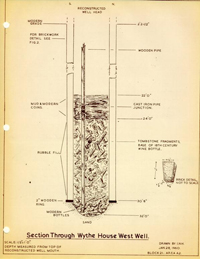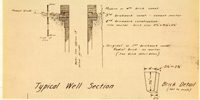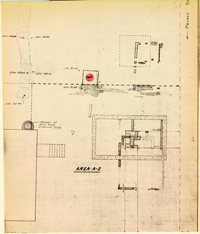George Wythe House Archaeological Report, Block 21 Building 4Originally entitled: "The Wythe House West Well"
Colonial Williamsburg Foundation Library
Research Report Series - 1488
Colonial Williamsburg Foundation
Library
Williamsburg, Virginia
1990
THE WYTHE HOUSE
WEST WELL
Archaeological Report
| Fig. 1 Section through well filling | Following p. 1 |
| Fig. 2 Section through wellhead as exposed in excavations of 1938 | Following p. 2 |
| Fig. 3 Detail of 1938 archaeological plans showing position of west well | Following p. 3 |
THE WYTHE HOUSE WEST WELL ARCHAEOLOGICAL REPORT OF EXCAVATIONS OF AUGUST 3-5, 1959
In an attempt to recover dating evidence for the structure of the Wythe House west well and to retrieve artifacts that might provide clues to colonial activities carried on in its vicinity, the filling of the well was cleaned out in August 1959.
The results of the operation, carried out by a crew from AC&M under the supervision of Messrs. N. Harmon and J. P. Bass and directed on the site by the staff of the Archaeological Section, proved to be completely negative. No evidence of eighteenth century filling was encountered, and cut nails used in the wooden ring at the bottom precluded the lining from having been sunk before c. 1800.
Contents of the well
The shaft was open to a depth of 22'-0" below the present head and normally contained approximately two feet of water, although this occasionally increased to as much as ten feet after heavy rains. An iron pipe ran into the side of the lining from the east carrying rain water from the gutters of the Wythe House.
After the water had been removed, a stratum of black silt was encountered, made up almost entirely of organic materis, i.e., leaves, twigs, seeds, etc., liberally sprinkled with flash bulbs and pennies thrown down by visitors. The stratum was found to be 2'-0" in thickness and also contained a modern candle and part of an unfinished T-shaped hinge, the latter appeared to be a modern reproduction.
 Section Through Wythe House West Well
Section Through Wythe House West Well
Protruding from the silt was a drilled 3¼" square timber with a bore of 1-7/8", broken off at the top, but with a surviving length of 5'¼". This timber was rounded at its lower end and was thrust into a short cast-iron junction pipe, the latter housing the top of a similar length of bored timber. This 3¼" square timber with a bore diameter of 2" had a total length protruding from the 9½" of iron pipe of 8'-3½". The tube was solid. At the lower end and above this section were four drilled holes of 1½" diameter through which the water was sucked. Although the pipe was withdrawn by the well digger before its end was exposed, there is little doubt that it terminated at or close to the bottom of the well.1
At a depth from the surface of 24'-0" a large number of stone fragments and pieces of well bricks were encountered and this type of fill continued to the bottom of the shaft. Scattered through it were numerous pennies that had worked their way down from the top silt, most of them dating in the 1940's and 1950's and none dating earlier than 1919. Also recovered were two nickels, and one dime.2
The pieces of stone found in the well were of little
importance, most of them apparently being pieces of waste paving stone. Mr. O.
M. Bullock, Supervisor of Architectural Research tentatively identified the
stone as a granite native to the Richmond area.3 Of
more interest were a few architectural or funiary moulding fragments that
probably dated from the
 Fig.
2 Section through Wythe House West Wellhead from archaeological drawing of
1938. Scale ¼" = 1'
3
eighteenth century. Two fragments of eighteenth century Purbeck tombstones,
presumably from Bruton Parish Churchyard, were also found and these bear the
incomplete inscriptions:
Fig.
2 Section through Wythe House West Wellhead from archaeological drawing of
1938. Scale ¼" = 1'
3
eighteenth century. Two fragments of eighteenth century Purbeck tombstones,
presumably from Bruton Parish Churchyard, were also found and these bear the
incomplete inscriptions:
| ]he[ | ||
| ] ct h[ | and[ | |
| ] n w[ | & | CATH[ |
| ]Frg[ | ||
| ]rect[ |
At the bottom of the well in a silted concavity below the wooden ring were found a quantity of beer, coca cola and other bottles. These were useful as dating evidence in that two items were marked with the dates at which patents had been issued to them. These were as follows:
- 1.1. Glass jar marked PAT IN U.S. Dec.22.1903. and July 17.1906.
- 2.2. "Nu Grape" bottle marked PAT. March 9. 1920.
The only objects of eighteenth century date from the entire filling (other than the previously mentioned stones) were a fragment of a Chinese porcelain bowl and a single beverage bottle bottom stemming from the middle of that century. But as both these items were found amid the stones and other debris overlying the modern bottles there can be no denying that they were thrown down comparatively recently.
The contents of the well cannot have been inserted before 1920 and is in consequence of no archaeological importance.
The structure of the well
The shaft was built from well bricks measuring 7¼ x
4-1/6 x 2½ x 2¾", apparently somewhat too small for the 3'-0"
diameter of the well.
 Fig. 3. Detail from archaeological plan of Wythe House excavations, 1938.
Scale: ¼" = 1'0".
4
Although of the same shape and size as the bricks below, those close to the
reconstructed head appeared to be of a different quality, the former being in
good condition, while those at the top were considerably weathered. The
mortarless brick shaft did not change in character as it went down, the bricks
being of the same size and color until they reached the wooden ring at a depth
of 30'-8". The bottom course comprised 45 bricks creating an internal
diameter of 2'-10". The ring itself was no more than 2" in thickness,
much decayed and held together with cut nails. One of these nails had not
been used and was thrust between an overlapping joint of the ring and was
recovered intact. The nail was flat-ended and had a total length of 2". Such a nail could not have been manufactured prior to c. 18001
and thus precludes the structure resting on top of it from being of colonial
date.
Fig. 3. Detail from archaeological plan of Wythe House excavations, 1938.
Scale: ¼" = 1'0".
4
Although of the same shape and size as the bricks below, those close to the
reconstructed head appeared to be of a different quality, the former being in
good condition, while those at the top were considerably weathered. The
mortarless brick shaft did not change in character as it went down, the bricks
being of the same size and color until they reached the wooden ring at a depth
of 30'-8". The bottom course comprised 45 bricks creating an internal
diameter of 2'-10". The ring itself was no more than 2" in thickness,
much decayed and held together with cut nails. One of these nails had not
been used and was thrust between an overlapping joint of the ring and was
recovered intact. The nail was flat-ended and had a total length of 2". Such a nail could not have been manufactured prior to c. 18001
and thus precludes the structure resting on top of it from being of colonial
date.
Conclusions
The well had been thoroughly cleaned out early in the present century and at sometime after 1920 received a legacy of bottles followed by a deposition of stone and other fragments. The latter filling might be attributed to a time when extensive clearing up operations were undertaken on the site - perhaps when the Wythe House was converted to a parish house.
While the evidence of the nails recovered from the wooden ring ensures that the lining dates after c. 1800, no closer dating is forthcoming from the archaeological discoveries. However, it seems reasonable to suggest that this well was dug during the third quarter of the nineteenth century when the south well went out of use and was filled with Professor 5 Millington's trash.1
It has been suggested that the well might have been completely relined, making use of the shaft originally dug for a colonial well, but no evidence of relining was recovered from the clearance of the existing well. But the fact that the ring rested on an undisturbed bed of marl proved that any previous well can have been no deeper than the present lining. At the time of writing plans to examine the exterior of the lining in search of evidence of a disturbed previous structure have not been sanctioned.
I. N. H.
August 7, 1959
Approved by Mr. Orin M. Bullock, Jr. September 1959
Completed. February 1960
Footnotes
 Archaeological Survey of Foundations - Wythe House
Archaeological Survey of Foundations - Wythe House